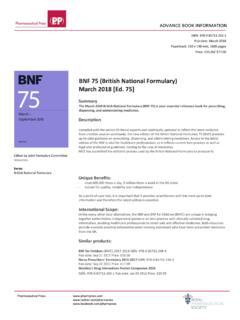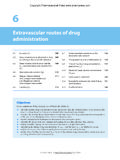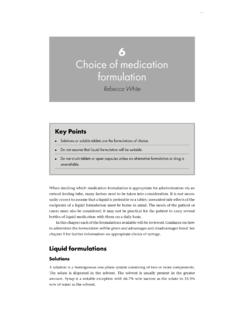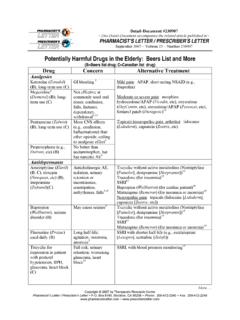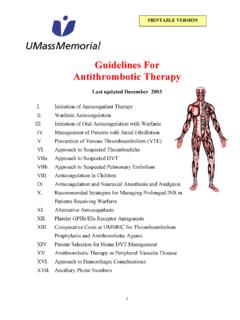Transcription of Physicochemical properties of drugs - Pharmaceutical Press
1 333 Physicochemical properties ofdrugsAs has been stated before, most of the drugs used in medicine behave insolution as weak acids, weak bases, or sometimes as both weak acids andweak bases. In this chapter we will explore the reasons why drugs behaveas acids or bases and what effects ionisation has on the properties of thedrug, and develop strategies to separate mixtures of drugs on the basis ofchanges in their solubility in various most important thing to realise about acidic and basic drugs is thatvalues ofpKaandpKbquoted in the literature tell youabsolutely nothingabout whether the drug in question is an acid or a base.
2 ThepKaandpKbvalues give information about the strength of acids and bases; they tell youthe pH at which 50% of the drug is ionised, but they do not tell you whethera drug behaves as an acid or a base in solution. Amines, for example, arebasic and havepKavalues of approximately 9, while phenols are acidic andtypically havepKavalues of around only sure way to know whethera drug is acidic or basic is to learn the functional groups that confer acidityand basicity on a molecule. This should be done even if it means learning thenames of the functional groups the way you learned multiplication tables atprimary school.
3 There are only a few to learn and the important examplesare listed below along with some common acidsAccording to the Br nsted Lowry definition, an acid is a substance thationises to donate protons to its surroundings. In aqueous solution this isrepresented asHA+H2O H3O++A ( )where HA is the acid; water accepts the proton and acts as a base;H3O+isa solvated proton, sometimes called the conjugate acid of the base; andA is the anion of the acid. The equilibrium constant for this reaction is theSample chapter fromEssentials of Pharmaceutical ChemistrySample chapter copyright Pharmaceutical Press58 Essentials of Pharmaceutical Chemistryacidity constantKaand is expressed mathematically asKa=[H3O+][A ]HA( )(taking[H2O]to be effectively constant for dilute solutions).
4 From Eq. ( ) it can be seen that, sinceKais a simple ratio, the higherthe numerical value ofKathe stronger will be the acid. As stated in Chapter1, however, the strength of most acids (and bases) is expressed by the termpKa, wherepKa= logKa( )SincepKais the negative logarithm ofKa, it follows that thelowerthe valueofpKathestrongerwill be the acid and that on a log scale a difference ofone unit inpKareflects a tenfold difference in acid most commonly occurring functional group conferring acidity ondrug molecules is the carboxyl group, which ionises as shown in Fig. anion formed by ionisation of the acid is stabilised by the process ofresonance.
5 Neither of the two conventional structures ([a] and [b]) of thecarboxylate anion shown in Fig. is correct. A double bond inC=Oismuch shorter than aC Osingle bond (due to sideways repulsion of theelectrons in the bond), yet when the carbon oxygen bond lengths of thecarboxylate anion are measured ( by X-ray diffraction) they are foundto be precisely the same length: shorter than a single bond and longer thana double bond. It would also be wrong to say that the actual structure ofthe carboxylate anion is a single structure rapidly interchanging between[a] and [b]. Structures [a] and [b] represent extremes of the actual is better to say the actual structure of the anion is a single, symmetricalstructure intermediate between [a] and [b] in which the charge is delocalised(distributed) around the carboxylate group.
6 This effect is calledresonanceand is invoked when not all of the observed properties of a compound canbe explained or represented by conventional structures. The carboxylateanion is said to be aresonance hybridand [a] and [b] arecanonical formsthatcontribute to it. The resonance hybrid is generally a more stable structurethan either of the canonical forms, which means it is more likely to exist,which is another way of saying the carboxylic acid is more likely to ionise,which in turn, means it is a stronger acid. It is considered chemical goodpractice to write the formula of a carboxylic acid as R-COOH since thetwo oxygen atoms are non-equivalent (one issp2hybridised in a carbonylgroup while the other issp3hybridised attached to hydrogen).
7 The anionof a carboxylic acid is written as R-CO 2because the two oxygen atoms arenow equivalent due to effect of resonance may be seen when the acidity of a simple carb-oxylic acid such as acetic acid is compared with the acidity of an alcoholSample chapter fromEssentials of Pharmaceutical ChemistryPhysicochemical properties of drugs59 CROHOCRO O+ H+Figure ionisation of a carboxylic CROOO O (a)(b)Figure stabilisation of the carboxylate as ethanol. Both compounds can ionise to liberate a proton, but whilethe anion formed on ionisation of acetic acid is resonance-stabilised, theethoxide anion formed on ionisation of ethanol is not so stabilised and thenegative charge resides wholly on the oxygen atom (Fig.)
8 CH3 COHOCH3 CO O+ H+pKa = CH2 OHCH3 CH2O + H+pKa ~ 16 Figure ionisations of acetic acid and acetic acid is while thepKaof ethanol is approximately16. This means that acetic acid is almost a hundred thousand million (or1011) times more acidic than ethanol. Alcohols are much weaker acids thanwater and in biological systems are considered to be neutral. To bring aboutthe ionisation of an alcohol requires the use of a very strong base such asmetallic chapter fromEssentials of Pharmaceutical Chemistry60 Essentials of Pharmaceutical ChemistryA number of commonly used drugs are carboxylic acid derivatives.
9 Theseinclude aspirin ( ), the anticancer compound methotrexate ( , and ) and the diuretic (previously called frusemide in the UK; ). The structures of these compounds are shown in Fig. structures of aspirin, methotrexate and of thepKavalue of a drug and the approximate rule of thumbintroduced in Chapter 1 allows a prediction of the extent to which each ofthese drugs is ionised at the pH of human blood ( ). For aspirin andfurosemide acid withpKavalues of and , the answer is that a given dose of drug will be ionised at the pH of blood or intracellularfluid. For methotrexate, the answer will be slightly less, but still greaterthan 99%.
10 This strongly suggests that these drugs are pharmacologicallyactive as the anion, and interact with their individual receptors in the ionicform. This conclusion has been reached without considering the detailedthree-dimensional structure of each drug s receptor molecule, merely bySample chapter fromEssentials of Pharmaceutical ChemistryPhysicochemical properties of drugs61applying knowledge of thepKaand an appreciation of the extent to whichdrugs ionise in solution. Deductions of this type form the basis ofmedicinalchemistry, the science of rational drug commonly encountered acidic functional group found in drugmolecules is phenol, or hydroxybenzene.



